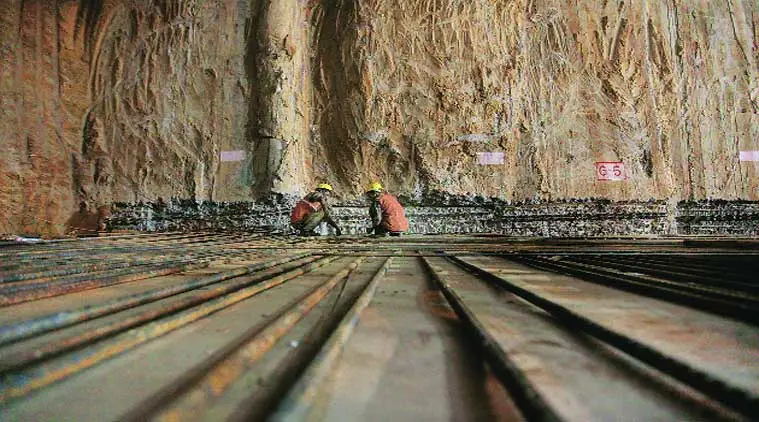- India
- International
Hauz Khas set to get deepest underground metro station by March 2016
The new Hauz Khas station, set to be deepest in Delhi at 29 metres, is 50 per cent complete.
 Work going on at the new Hauz Khas Metro station. The station will have five levels. ( Source: Express photo by Ravi Kanojia )
Work going on at the new Hauz Khas Metro station. The station will have five levels. ( Source: Express photo by Ravi Kanojia )
Delhi Metro Rail Corporation (DMRC) has already completed more than 50 per cent of the civil work in the deepest ever Metro station being constructed at Hauz Khas. This station, DMRC officials said, will serve as an interchange point between the Yellow Line (Jahangirpuri to HUDA City Centre) and the upcoming Magenta Line on the Outer Ring Road (Janakpuri to Botanical Garden). Tunnel boring has also begun at the next station, IIT, and the work will be completed shortly, officials said.
Constructed 29 metres below the ground, the new Hauz Khas station will surpass the depth of the Chawri Bazar station, which at 25 metres, is the deepest station now. The new Hauz Khas station will also be the first one to have five levels. At present, Metro stations in Delhi and NCR have a maximum of three levels.
“There will be three intermediate levels, followed by a concourse and a roof. The rails at Hauz Khas will be laid at a depth of 29 metres from the ground level. It will be connected to the existing Hauz Khas station by a 150 metre-long subway,” a senior DMRC official told Newsline.
The Malviya Nagar flyover, which lies just below the under-construction subway, will be given five-stage diversions over the next one-and-a-half years to ensure smooth flow of traffic on the stretch.
Using the top-down method of construction, DMRC has already put up diaphragm walls along the perimeter of the new station and has completed the casting at the roof level. Of the 260 metres of casting at the course level, about 220 metres is complete.

“That is more than 80 per cent of our work at the concourse. Around 40 metres of casting is still left,” he said. The bottom levels are also under construction, DMRC officials said. The diaphragm walls at the Hauz Khas interchange, too, will be the one of the deepest in DMRC at 36 metres below the ground. Engineers have also built 40 metre-long temporary columns to support the slabs till construction on permanent columns begins.

Explaining the top-down construction method, the engineer said the walls are the first to be constructed as perimeter of the station. “After that, the excavation begins.” While casting roof levels, square-shaped shafts are left in the middle for excavators to be lowered and tunnel boring machines to be pulled up. “We subsequently cast the concourse and other levels. The top-down method is a very safe, convenient and fast. It also safeguards the existing buildings around the station site,” the official said.
The DMRC carries out conditional surveys before beginning excavations and monitors the surrounding buildings on a regular basis to ensure no damage is caused to them due to the vibrations and impact caused by construction work. Nearly 400 personnel are working in three shifts round-the-clock to meet the March 2016 deadline set for the station to be completed.
Touted as one of the busiest stations of the network, the interchange is expected to decongest Rajiv Chowk Metro station significantly as it will provide a direct route between Noida and Gurgaon. Once the station is functional, commuters will no longer have to change at Rajiv Chowk.
Once construction is complete, DMRC will also redevelop the DDA park it has taken over for the construction. “However, no property development plans are in the offing. This station will be extremely busy, with no space to develop any major business models,” a DMRC spokesperson said.
Buzzing Now
May 10: Latest News
- 01
- 02
- 03
- 04
- 05







































